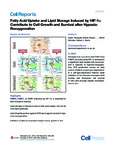Fatty acid uptake and lipid storage induced by HIF-1α contribute to cell growth and survival after hypoxia-reoxygenation.
| dc.contributor.author | Bensaad, K | en |
| dc.contributor.author | Favaro, E | en |
| dc.contributor.author | Lewis, CA | en |
| dc.contributor.author | Peck, B | en |
| dc.contributor.author | Lord, S | en |
| dc.contributor.author | Collins, JM | en |
| dc.contributor.author | Pinnick, KE | en |
| dc.contributor.author | Wigfield, S | en |
| dc.contributor.author | Buffa, FM | en |
| dc.contributor.author | Li, J-L | en |
| dc.contributor.author | Zhang, Q | en |
| dc.contributor.author | Wakelam, MJO | en |
| dc.contributor.author | Karpe, F | en |
| dc.contributor.author | Schulze, A | en |
| dc.contributor.author | Harris, AL | en |
| dc.date.accessioned | 2016-08-09T14:55:14Z | |
| dc.date.available | 2016-08-09T14:55:14Z | |
| dc.date.issued | 2014-10-09 | en |
| dc.identifier.uri | http://hdl.handle.net/10026.1/5249 | |
| dc.description.abstract |
An in vivo model of antiangiogenic therapy allowed us to identify genes upregulated by bevacizumab treatment, including Fatty Acid Binding Protein 3 (FABP3) and FABP7, both of which are involved in fatty acid uptake. In vitro, both were induced by hypoxia in a hypoxia-inducible factor-1α (HIF-1α)-dependent manner. There was a significant lipid droplet (LD) accumulation in hypoxia that was time and O2 concentration dependent. Knockdown of endogenous expression of FABP3, FABP7, or Adipophilin (an essential LD structural component) significantly impaired LD formation under hypoxia. We showed that LD accumulation is due to FABP3/7-dependent fatty acid uptake while de novo fatty acid synthesis is repressed in hypoxia. We also showed that ATP production occurs via β-oxidation or glycogen degradation in a cell-type-dependent manner in hypoxia-reoxygenation. Finally, inhibition of lipid storage reduced protection against reactive oxygen species toxicity, decreased the survival of cells subjected to hypoxia-reoxygenation in vitro, and strongly impaired tumorigenesis in vivo. | en |
| dc.format.extent | 349 - 365 | en |
| dc.language | eng | en |
| dc.language.iso | eng | en |
| dc.subject | Cell Hypoxia | en |
| dc.subject | Cell Line, Tumor | en |
| dc.subject | Cell Proliferation | en |
| dc.subject | Fatty Acids | en |
| dc.subject | Glioblastoma | en |
| dc.subject | Humans | en |
| dc.subject | Hypoxia-Inducible Factor 1, alpha Subunit | en |
| dc.subject | Lipid Metabolism | en |
| dc.subject | Oxidation-Reduction | en |
| dc.subject | Oxygen | en |
| dc.title | Fatty acid uptake and lipid storage induced by HIF-1α contribute to cell growth and survival after hypoxia-reoxygenation. | en |
| dc.type | Journal Article | |
| plymouth.author-url | https://www.ncbi.nlm.nih.gov/pubmed/25263561 | en |
| plymouth.issue | 1 | en |
| plymouth.volume | 9 | en |
| plymouth.publication-status | Published | en |
| plymouth.journal | Cell Rep | en |
| dc.identifier.doi | 10.1016/j.celrep.2014.08.056 | en |
| plymouth.organisational-group | /Plymouth | |
| plymouth.organisational-group | /Plymouth/REF 2021 Researchers by UoA | |
| plymouth.organisational-group | /Plymouth/REF 2021 Researchers by UoA/UoA01 Clinical Medicine | |
| plymouth.organisational-group | /Plymouth/REF 2021 Researchers by UoA/UoA01 Clinical Medicine/UoA01 Clinical Medicine | |
| dc.publisher.place | United States | en |
| dcterms.dateAccepted | 2014-08-22 | en |
| dc.identifier.eissn | 2211-1247 | en |
| dc.rights.embargoperiod | Not known | en |
| rioxxterms.versionofrecord | 10.1016/j.celrep.2014.08.056 | en |
| rioxxterms.licenseref.uri | http://www.rioxx.net/licenses/all-rights-reserved | en |
| rioxxterms.licenseref.startdate | 2014-10-09 | en |
| rioxxterms.type | Journal Article/Review | en |


